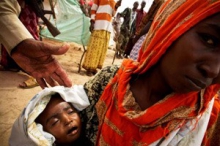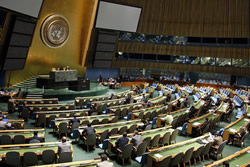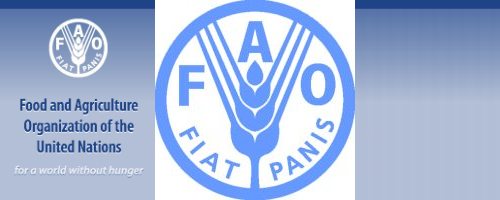Famine spreads further in Somalia. FAO calls for stepped up response.
Famine spreads further in Somalia
FAO calls for stepped up response
 Nairobi/Rome- FAO today called for increased efforts to stem the food crisis in the Horn of Africa as famine spread to a sixth area of Somalia, threatening 750 000 people with starving to death in the next four months.
Nairobi/Rome- FAO today called for increased efforts to stem the food crisis in the Horn of Africa as famine spread to a sixth area of Somalia, threatening 750 000 people with starving to death in the next four months.
Latest data released today by the Food Security and Nutrition Analysis Unit for Somalia (FSNAU), which is managed by FAO in close collaboration with USAID’s Famine Early Warning Systems Network (FEWS NET), indicated that famine has spread to Bay region, one of Somalia’s most productive areas. Five other regions had previously been declared in a state of famine.
Together with ongoing crises in the rest of the country, the number of Somalis in need of humanitarian assistance has increased from 2.4 million to 4 million in the last eight months, with 3 million of them in the country’s south.
Bleak picture
“Though these figures paint a bleak picture for Somalia, there is a window of opportunity for the humanitarian community to stop and reverse this undesirable trend by supporting farmers and herders in addition to other emergency interventions,” Luca Alinovi, FAO’s Officer in Charge for Somalia, told a press conference in Nairobi.
Bay region is a breadbasket for Somalia, producing over 80 percent of the country’s sorghum. Record levels of acute malnutrition have been registered there, with 58 percent of children under five acutely malnourished, and a crude death of more than two deaths per 10 000 per day.
Bay region joins five other areas hit by famine including Bakool agropastoral communities in Lower Shabelle region, the agropastoral areas of Balcad and Cadale districts of Middle Shabelle, the Afgoye corridor IDP settlement, and the Mogadishu IDP community.
Widespread famine
Despite current interventions, projections indicate that famine will become widespread throughout southern Somalia by the end of 2011.
“In the current food security situation, famine conditions are expected to spread to agropastoral populations in Gedo Hiran Middle Shabelle and Juba regions and the riverine populations of Juba and Gedo in the coming four months,” said Grainne Moloney, FSNAU’s Chief Technical Adviser.
Post-harvest finding showed this year’s cereal crop to be the lowest in 17 years. Dwindling stocks of local cereals have sent cereal prices soaring 300 percent over the last year and nearly half a million acutely malnourished children across Somalia require urgent nutritional treatment.
FAO has appealed for $70 million for Somalia to provide agricultural emergency assistance for one million farmers and herders. With increasing access to many parts of southern Somalia, FAO is currently carrying out emergency interventions and is opening two new offices in Mogadishu and Dolo and several suboffices in each region.
Improved seeds
“We have already embarked on mass production of improved seeds and procured 5 000 tonnes of fertilizer, among other farm inputs, in preparation for the next planting season from October to December,” said Alinovi. FAO’s current interventions are benefiting of over one million people in Somalia’s most affected regions.
FAO has received confirmed donations of $20 million from the United Nations’ Central Emergency Response Fund (CERF), the Common Humanitarian Fund (CHF), Australia, Spain, Switzerland and the United Kingdom, and another $21 million in pledges from the European Commission – Humanitarian Aid and Civil Protection (ECHO), the United States of America, Belgium and the World Bank. Talks with other countries are ongoing.
Famine is classified using a tool called the Integrated Food Security Phase Classification (IPC). FSNAU and FEWS NET adhere to the IPC standards when declaring a famine on the basis of at least three criteria being present: severe lack of food access for 20 percent of the population, acute malnutrition exceeding 30 percent and a Crude Death Rate exceeding two deaths per 10 000 population per day.
The current crisis affects the whole Horn of Africa region including the northern part of Kenya and southern parts of Ethiopia and Djibouti where large areas are classified as being in a state of humanitarian emergency.
###
> UN Food and Agriculture Organization (FAO).
The Food and Agriculture Organization of the United Nations (FAO) is an intergovernmental organization and has 191 Member Nations, two associate members and one member organization, the European Union. Achieving food security for all is at the heart of FAO’s efforts – to make sure people have regular access to enough high-quality food to lead active, healthy lives.

FAO’s mandate is to raise levels of nutrition, improve agricultural productivity, better the lives of rural populations and contribute to the growth of the world economy.
The Food and Agriculture Organization of the United Nations (FAO) is working with its Members and the entire international community for achievement of the Millennium Development Goals.
These eight goals – each with specific targets and indicators – are based on the United Nations Millennium Declaration, signed by world leaders in September 2000. They commit the international community to combating poverty, hunger, disease, illiteracy, environmental degradation, and discrimination against women.
![]()
The eight Millennium Development Goals are:
Goal 1: Eradicate extreme poverty and hunger
Goal 2: Achieve universal primary education
Goal 3: Promote gender equality and empower women
Goal 4: Reduce child mortality
Goal 5: Improve maternal health
Goal 6: Combat HIV/AIDS, malaria and other diseases
Goal 7: Ensure environmental sustainability
Goal 8: Develop a Global Partnership for Development
* More information at UN Food and Agriculture Organization (FAO)
###
> United Nations (UN).
 The United Nations was established on 24 October 1945 by 51 countries committed to preserving peace through international cooperation and collective security. Today, nearly every nation in the world belongs to the UN: membership totals 192 countries.
The United Nations was established on 24 October 1945 by 51 countries committed to preserving peace through international cooperation and collective security. Today, nearly every nation in the world belongs to the UN: membership totals 192 countries.
When States become Members of the United Nations, they agree to accept the obligations of the UN Charter, an international treaty that sets out basic principles of international relations. According to the Charter, the UN has four purposes:
- to maintain international peace and security;
- to develop friendly relations among nations;
- to cooperate in solving international problems and in promoting respect for human rights;
- and to be a centre for harmonizing the actions of nations.
###
* The above story is adapted from materials provided by United Nations (UN)
** More information at United Nations (UN)





















